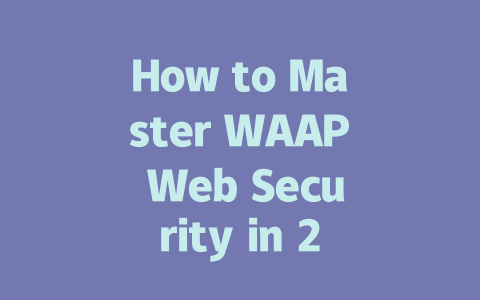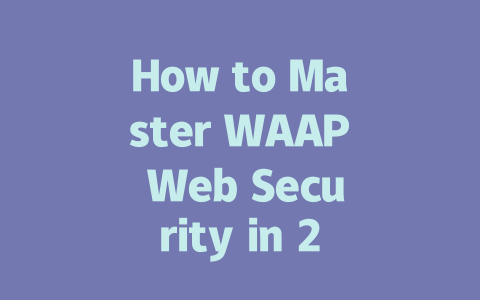You’ve probably heard the term “WAAP” being thrown around a lot lately, right? If you’re wondering what it is and why it matters, let me break it down for you. WAAP (Web Application and API Protection) isn’t just another buzzword—it’s becoming essential as more businesses move online. Think about it: how frustrating would it be if your website got hacked or went down because of an attack? That’s where WAAP comes in. Let’s dive into how you can secure your site without losing your mind.
Why WAAP Matters Now More Than Ever
Let me start with a real-life example. Last year, I helped a friend optimize their e-commerce store’s security after they were hit by a DDoS attack. It cost them thousands in lost sales—not to mention the headache of restoring everything. After setting up proper WAAP measures, they didn’t experience another major issue. This goes to show that prevention is worth its weight in gold.
So, why does WAAP matter so much in 2025? Simple: cyberattacks are getting smarter and harder to defend against. Bots, API vulnerabilities, and malicious actors are all threats lurking around the corner. By implementing WAAP, you give yourself peace of mind knowing your data—and your users’ data—is protected.
Understanding the Basics of WAAP
Before jumping into strategies, let’s clarify what WAAP actually means. Essentially, WAAP combines several layers of protection:
Now, here’s the kicker—just throwing these tools at your problem won’t cut it. You need to know how to use them effectively.
Step-by-Step Guide to Securing Your Website with WAAP
Alright, let’s get practical. Here’s a step-by-step approach I’ve found works best when securing websites using WAAP:
First things first: identify weak points in your current setup. Ask yourself questions like:
To make this easier, consider running vulnerability scans. Tools like OWASP ZAP (free!) or commercial options such as FortiWeb can pinpoint areas needing attention.
Personal Experience:
When helping my friend’s business, one scan revealed an open API endpoint anyone could exploit. Plugging that hole immediately reduced potential risks significantly.
Not all WAAP solutions are created equal. Some focus on specific issues while others offer comprehensive coverage. For most small-to-medium enterprises, cloud-based WAAP services work wonders since they scale automatically based on demand.
Here’s a quick comparison table to help decide:
| Feature | Cloudflare WAAP | Akamai WAAP | F5 WAAP |
|---|---|---|---|
| Bot Management | Yes | Yes | Yes |
| DDoS Protection | Yes | Yes | Limited |
| Cost | Moderate | Higher | High |
As you can see, each option has pros and cons depending on your needs. My recommendation? Start with something scalable like Cloudflare if budget is tight but still want robust features.
This part might sound fancy, but trust me, it’s simpler than you think. Modern WAAP platforms often include AI-driven detection systems that spot anomalies before they become problems. For instance, imagine noticing unusual traffic spikes late at night—that could indicate a bot trying to brute-force login credentials.
Google itself recommends adopting machine learning techniques to stay ahead of evolving threats. While not mandatory, integrating AI components gives you an edge over purely manual methods.
Practical Tip:
Set alerts for unusual behavior. Whether it’s via email or SMS notifications, staying informed helps react quickly during emergencies.
Lastly, don’t underestimate the power of education. Even the best WAAP solution won’t save you if someone inside your organization accidentally exposes sensitive information. Regular training sessions go a long way toward reinforcing good practices.
For instance, teach employees to recognize phishing emails or double-check links before clicking. These seemingly small habits reduce human error dramatically.
If you try any of these methods, drop me a line! Hearing how they worked—or didn’t—for others makes this whole process even better. Happy securing!
If you’re thinking about the difference between WAAP and traditional WAF, it’s kind of like comparing a standard lock to a full home security system. Both are designed to keep intruders out, but WAAP takes things much further. Traditional WAFs focus mainly on filtering web traffic, which is great if your biggest concern is stopping bad actors from accessing your site directly. But WAAP adds layers like API protection, bot management, and DDoS mitigation—all crucial pieces in today’s digital landscape. It’s like saying, “Sure, I’ll lock my door, but I’ll also install cameras, motion sensors, and a guard dog just in case.” WAAP doesn’t replace WAF; instead, it builds on that foundation to give you broader, more robust protection.
When people ask whether they can use WAAP with a shared hosting setup, the answer is absolutely yes. Most cloud-based WAAP solutions are built to integrate smoothly with shared hosting environments. That said, there are limits to what you can customize compared to having a dedicated server. For example, some advanced configurations might not be fully supported because shared hosting has its own constraints. So, when choosing a provider, make sure they explicitly support shared hosting setups. You don’t want to sign up for something only to find out later it won’t work well with your current infrastructure.
# Frequently Asked Questions
# How does WAAP differ from traditional WAF?
While both WAAP and WAF aim to protect web applications, WAAP offers a broader range of protections. Traditional WAFs focus primarily on securing web traffic, whereas WAAP incorporates additional layers like API protection, bot management, and DDoS mitigation. Essentially, WAAP builds upon the foundation of WAF to provide more comprehensive security.
# Can I implement WAAP if my website is hosted on a shared server?
Yes, you can still implement WAAP even if your website is hosted on a shared server. Many cloud-based WAAP solutions are designed to work seamlessly with shared hosting environments. However, the level of customization may be limited compared to dedicated servers, so it’s important to choose a provider that supports shared hosting configurations.
# What is the average cost range for implementing WAAP in 2025?
The cost of implementing WAAP varies widely depending on the size of your business and the specific features required. For small businesses, costs typically range from $5-12 per month for basic plans, while larger enterprises might pay hundreds or thousands monthly for premium solutions with advanced threat detection capabilities.
# Is WAAP necessary for static websites with no APIs?
Even though static websites without APIs might seem less vulnerable, they can still face threats such as cross-site scripting (XSS) attacks or unauthorized access attempts. Implementing WAAP provides an extra layer of protection against these risks, ensuring your site remains secure regardless of its complexity.
# How long does it usually take to set up WAAP for a new website?
Setting up WAAP depends on the platform and your technical expertise. With cloud-based services, it can take as little as a few hours to configure basic settings. However, fine-tuning advanced features like custom rulesets or integrating with third-party tools may require several days, especially for complex websites.




